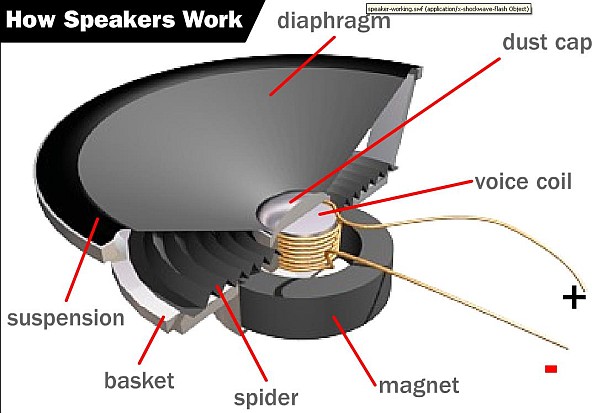Summary of How Speakers Work
The article explains how speakers convert electrical signals into sound by vibrating a diaphragm to create air pressure waves that our ears perceive as sound. Sound is caused by vibrations that cause air particles to move, producing waves with varying frequency and amplitude, which we interpret as pitch and volume. Speakers reverse the process of microphones by translating electrical signals back into physical vibrations. Key components of a speaker driver include the cone or dome diaphragm, suspension, voice coil, spider, and basket, all working together to produce accurate sound vibrations.
Parts used in the Speaker Project:
- Diaphragm (cone or dome)
- Suspension (surround)
- Voice coil
- Spider
- Basket (driver frame)
In any sound system, ultimate quality depends on the speakers. The best recording, encoded on the most advanced storage device and played by a top-of-the-line deck and amplifier, will sound awful if the system is hooked up to poor speakers.
A system’s speaker is the component that takes the electronic signal stored on things like CDs, tapes and DVDs and turns it back into actual sound that we can hear.
In this article, we’ll find out exactly how speakers do this. We’ll also look at how speaker designs differ, and see how these differences affect sound quality. Speakers are amazing pieces of technology that have had a profound impact on our culture. But at their heart, they are remarkably simple devices.
To understand how speakers work, you first need to understand how sound works.
Inside your ear is a very thin piece of skin called the eardrum. When your eardrum vibrates, your brain interprets the vibrations as sound — that’s how you hear. Rapid changes in air pressure are the most common thing to vibrate your eardrum.
An object produces sound when it vibrates in air (sound can also travel through liquids and solids, but air is the transmission medium when we listen to speakers). When something vibrates, it moves the air particles around it. Those air particles in turn move the air particles around them, carrying the pulse of the vibration through the air as a traveling disturbance.
To see how this works, let’s look at a simple vibrating object — a bell. When you ring a bell, the metal vibrates — flexes in and out — rapidly. When it flexes out on one side, it pushes out on the surrounding air particles on that side. These air particles then collide with the particles in front of them, which collide with the particles in front of them and so on. When the bell flexes away, it pulls in on these surrounding air particles, creating a drop in pressure that pulls in on more surrounding air particles, which creates another drop in pressure that pulls in particles that are even farther out and so on. This decreasing of pressure is called rarefaction.
In this way, a vibrating object sends a wave of pressure fluctuation through the atmosphere. When the fluctuation wave reaches your ear, it vibrates the eardrum back and forth. Our brain interprets this motion as sound.
Differentiating Sound
We hear different sounds from different vibrating objects because of variations in:
- Sound-wave frequency – A higher wave frequency simply means that the air pressure fluctuates faster. We hear this as a higher pitch. When there are fewer fluctuations in a period of time, the pitch is lower.
- Air-pressure level – This is the wave’s amplitude, which determines how loud the sound is. Sound waves with greater amplitudes move our ear drums more, and we register this sensation as a higher volume.
A microphone works something like our ears. It has a diaphragm that is vibrated by sound waves in an area. The signal from a microphone gets encoded on a tape or CD as an electrical signal. When you play this signal back on your stereo, the amplifier sends it to the speaker, which re-interprets it into physical vibrations. Good speakers are optimized to produce extremely accurate fluctuations in air pressure, just like the ones originally picked up by the microphone. In the next section, we’ll see how the speaker accomplishes this.
In the last section, we saw that sound travels in waves of air pressure fluctuation, and that we hear sounds differently depending on the frequency and amplitude of these waves. We also learned that microphones translate sound waves into electrical signals, which can be encoded onto CDs, tapes, LPs, etc. Players convert this stored information back into an electric current for use in the stereo system.
A speaker is essentially the final translation machine — the reverse of the microphone. It takes the electrical signal and translates it back into physical vibrations to create sound waves. When everything is working as it should, the speaker produces nearly the same vibrations that the microphone originally recorded and encoded on a tape, CD, LP, etc.
Traditional speakers do this with one or more drivers.
Making Sound: Diaphragm
A driver produces sound waves by rapidly vibrating a flexible cone, or diaphragm.
- The cone, usually made of paper, plastic or metal, is attached on the wide end to the suspension.
- The suspension, or surround, is a rim of flexible material that allows the cone to move, and is attached to the driver’s metal frame, called the basket.
- The narrow end of the cone is connected to the voice coil.
- The coil is attached to the basket by the spider, a ring of flexible material. The spider holds the coil in position, but allows it to move freely back and forth.
Some drivers have a dome instead of a cone. A dome is just a diaphragm that extends out instead of tapering in.
For more Detail: How Speakers Work

